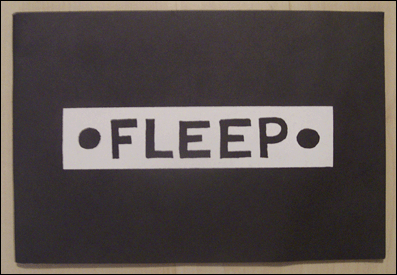The work of Jason Shiga first came to my attention in 2003, when he won an Eisner award for “Talent most deserving of wider recognition.” A few months later, I read a write-up on his then-current interactive comic book, ‘Hello World,’ and immediately ordered it from the USS Catastrophe store, hoping for the best.
‘Hello World’ turned out to be a tour de force in the relatively uncrowded field of interactive sequential narrative. In concept, it’s a bit like a combination of the obsessive block diagramming of software development and the traditional comic book narrative. Put simply, it’s an ambitious, illustrated “Choose Your Own Adventure” story, complete with a self-contained inventory system. The pages of the book itself are cut into two halves – the upper half contains the narrative, the lower half displays your current inventory.
It’s a bit difficult to explain the function of the book without actually experiencing it or seeing it in action, so I’ve provided a short video clip below. It’s a must-see, if only to truly appreciate the complexity of the book Mr. Shiga has put together.
(Download)
Hello World thoroughly blew my mind – when you think about the planning that went into executing such an idea, it’s just insane. I’m not sure how understandable the video above is, so I’ve pasted the official description, from the Shigabooks site, below:
“Hello World has two tiers that work independently of each other, not unlike the mix-n-match monster books of your childhood. Memory is stored in the bottom tier while the story takes place in the upper tier. The panels of the story are connected by a network of tubes. These tubes constantly dip in and out of the memory tier to determine what happens next in the story.”
Those familiar with my interests are by now realizing that this discovery — comic books that are NERDIER than NORMAL comic books?! — ranks pretty high on my list of best shit ever. Obviously, I had to find some of his other work. What follows are summaries of two of the other noteworthy books I eventually tracked down, as well as a ‘highlight reel’ of the new work that Jason recently added to his redesigned Shigabooks website. First though, some perspective on the guy behind these comics. Here’s the bio from his website:
“You could say that cartooning was in my blood. My father was an animator and worked on such shows as Obake no Q-taro and the legendary Bas Rankin Rudoph the Red Nosed Reindeer Christmas Special.”
“My parents have always been supportive of my interests. In highschool, I drew comic strips for the school newspaper and started to take up animation as well.
In 1998, I graduated from Cal with a degree in… Pure Mathematics. Why? Well, ever since I was ten years old, I had always thought that math was the best subject because even if you’re locked in a room for 25 years with no books you can still study it.”“Currently, I work at the Oakland Public Library as a Library Aide and do freelance cartooning for magazines.”
Meanwhile
‘Meanwhile’ is another interactive comic book that is less work-intensive on the part of the reader, and generally a much more readable iteration of the same ‘Choose Your Own Adventure’ concept — a reversal in balance of plot and principle when compared with ‘Hello World.’
In ‘Meanwhile,’ the paths the reader can follow are linked by pipes that extend between pages. Transitions from page to page are coordinated via tabs that extend beyond the edge of the page. If the reader follows a path to a tab, the page is turned and the reader continues on the newly-revealed page, starting from the tab. Confusing? The best way to get a feel for it is to experience it yourself, which is now possible online, as Jason has put together a Javascript version of the book here.
Like ‘Hello World,’ my first reaction to ‘Meanwhile’ was to marvel at the fact that someone was able to wrestle it all into a cohesive structure. The slightly-less-maniacally-detailed approach allows the plot to develop much more freely than in ‘Hello World.’ There’s a Mad scientist, a Time Machine, Secret Passwords, and Ice cream. All the good stuff. Shiga has actually isolated each panel, twist and turn contained in ‘Meanwhile’ and constructed a single ‘posterized’ version of the book, which he has exhibited at comic shows in the past. The finished product measures 5 feet by 5 feet, and can be seen here.
Fleep
‘Fleep’ isn’t an interactive comic, but it managed to capture my interest nonetheless. While it doesn’t turn sequential narrative on its ear in the same way many of Shiga’s other works attempt to, it does have elements of logic and puzzle-solving built into the relatively straight-forward narrative, which will appeal to many of the same readers that would be enthused by his other efforts. The story begins with the main character waking up locked in a windowless phone booth with no memory of the events landing him in said situation. The rest of the plot consists of this character trying to piece together the specifics of his predicament, based on clues in the phone booth, information obtained using the telephone, deduction, and math. Awesome.
Fleep has been available online in its entirety for quite awhile, and made the rounds of notorious nerd-hives such as metafilter sometime last year (mefi discussion here).
For those keeping score, the print version has the best production values of any of the books I’ve yet seen. Nice thick paper and better print quality than the interactive comics (Which I imagine are far more expensive to produce).
Further Online Works
I started piecing this entry together shortly after I originally ordered these books in early 2004. Research at the time seemed to indicate that Mr. Shiga had disappeared from the face of the earth shortly after winning the Eisner award. I emailed him in early 2005, asking about his next project and the availability of additional copies of “Hello World.” Here’s what he had to say:
“I’m currently working on a new
choose your own adventure type comic. The gimmick this time is that you get
to choose from 7-20 branches at every node (by the way, you only get to make
3 choices before a crazed gunman shoots you in the stomach). This project
should be finished within a couple months. I won’t make it in time for this
APE but it should be available by the next one.”“As for obtaining a copy of
“Hello World”, you’re out of luck as usscatastrophe sold out recently. I’m not
selling any copies on my site because I get killed on the shipping. I will
be selling copies at APE so you should come down if you’re still in the area.
About a month ago, Mr. Shiga emerged from e-exile and completely revamped his website, adding all sorts of new content and revealing that he’s been doing interactive comics for Nickelodeon Magazine in the interim (“I started working for Nickelodeon Magazine in 2003. It is an awesome responsibility knowing that my comics could potentially corrupt over a million children across the country. I do mostly double page interactive spreads which the kids seem to love.”). Some other highlights from the newly updated site, in relative order of recommendation, include:
- ‘Dead Lock‘ – An absolutely great autobiographical story, illustrated by a friend. A glimpse into how the mind that creates these works functions in the real world. The story comes from an entry on his circa-2003 livejournal. Awesome.
- ‘Bookhunter‘ a new longform strip about crime and libraries. Super good.
- Description of ‘Theater Eroika’, a scrapped project involving an interactive narrative with panels printed on 5 rotating paper ‘wheels.’
- ‘Every Dog Has His Day‘ – a comic strip with panels that are randomly ordered based on punchcard-like cuts.
- A few samples of his work for Nickelodeon are here.
- ‘Double Happiness,’ a book that won a Xeric award in 1999 is now also available online in its entirety.
You can order copies of several works directly from Mr. Shiga via this order form.



